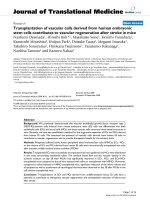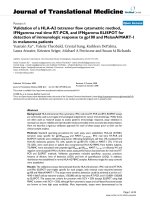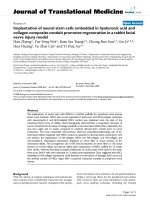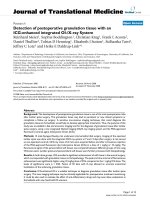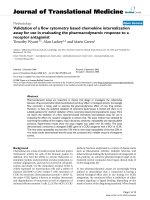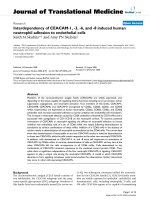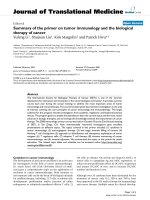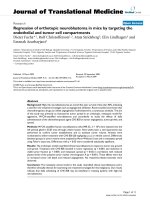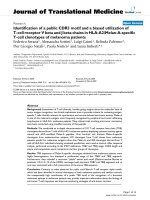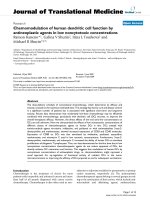báo cáo hóa học:" Repair of olecranon fractures using fiberWire without metallic implants: report of two cases" docx
Bạn đang xem bản rút gọn của tài liệu. Xem và tải ngay bản đầy đủ của tài liệu tại đây (1 MB, 4 trang )
CAS E REP O R T Open Access
Repair of olecranon fractures using fiberWire
without metallic implants: report of two cases
Akimoto Nimura
1*
, Teruhiko Nakagawa
2
, Yoshiaki Wakabayashi
1
, Ichiro Sekiya
3
, Atsushi Okawa
1
, Takeshi Muneta
1
Abstract
Olecranon fractures are a common injury in fractures. The tension band technique for olecranon fractures yields
good clinical outcomes; howev er, it is associated with significant complications. In many patients, implants irritate
overlying soft tissues and cause pain. This is mostly due to protrusion of the proximal ends of the K-wires or by
the twisted knots of the metal wire tension band. Below we described 2 cases of olecranon fractures treated with
a unique technique using FiberWire without any metallic implants. Technically, the fragment was reduced, and two
K-wires were inserted from the dorsal cortex of the distal segment to the tip of the olecranon. K-wire was
exchanged for a suture retriever, and 2 strands of FiberWire were retrieved twice. Each of the two FiberWires was
manually tensioned and knotted on the post erior surface of the olecranon. Bony unions could be achieved, and
patients had no complaint of pain and skin irritation. There was only a small loss of flexion and extension in
comparison with that of the contralateral side, and the patient did not feel inconvenienced in his daily life. Using
the method described, difficulty due to K-wire or other metallic implants was avoided.
Background
Olecranon fractures consist of approximately 10% of all
fractures around the elbow. The tension band fixation
is the commonest technique for relatively simple frac-
tures. This technique combines intramedullary Kirsh-
ner wires (K-wires) with a metal wire tension band.
The AO tension band technique yields good clinical
outcomes; however, it is a ssociated with significant
complications[1-3]. In many patients, implants irritate
overlying soft tissues and cause pain. This is mostly
caused by protrusion of the proximal ends of the
K-wires or by the metal wire tension band. It may be
necessary to remove the implant, occasionally before
fracture union. It is clearly desirable to find a fixation
method that enables surgeons t o rigidly fix the fracture
site without skin irritation related to the backing out
of hardware. The purpose of this case report is to
introduce our unique method for olecranon fractures
using high-strength suture without any metallic
implants.
Case presentation
Case 1
A 56-year-old, right-dominant woman fell on her left
elbow after an accident riding a bicycle. Two days after
injury, she was admitted to our hospital. Radiography
revealed an olecranon fracture, which was classified into
type II-A by Mayo classification [4] (Figure 1A). Surgery
was carried out 6 days after injury.
The operation was performed with the pat ient in the
supine position and the arm over the chest under regio-
nal anesthesia with an axillary block and under tourni-
quet control. By use of a posterior midline skin incision
on the tip of the olecranon, the fracture was exposed.
Two 2.0 mm K-wires were passed from the fracture site
of distal segment to dorsal cortex parallel. The two
K-wires were reversely directed using the same hole from
dorsal cortex to the fracture site (Figure 2A). The frag-
ment was reduced, and the two K-wires were inserted
from the dorsal cortex of the distal segment t o the tip of
the olecranon (Figure 2B). One of the K-wires was
exchanged into a suture retriever (Smith and Nephew,
Memphis,TN)usingthesamehole(Figure2C).Two
strands of No. 5 FiberWire (Arthrex, Naples, FL) were
retrieved twice in the same fashion. Each of the two No.
5 sutures was tensioned manually and knotted on the
posterior surface of the olecranon (Figure 1B, C, 2D).
* Correspondence:
1
Section of Orthopedic Surgery, Graduate School, Tokyo Medical and Dental
University, 1-5-45 Yushima, Bunkyo-ku, Tokyo, 113-8519 Japan
Full list of author information is available at the end of the article
Nimura et al. Journal of Orthopaedic Surgery and Research 2010, 5:73
/>© 2010 Nimura et al; licensee B ioMed Central Ltd. This is an O pen Access a rticle distributed under the terms of the Creative Commons
Attribution License ( which permits unre stricted use, distribution, and reproduction in
any medium, provided the original work is properly cited.
Postoperatively, the elbow was immobilized with a
plaster splint for 2 weeks. At one year after the sur-
gery, bony union still had been achieved (Figure 1D).
The patient had no complaint of pain and skin irrita-
tion. Range of motion at this time was 0°-15°-145° in
flexion-extension. The patient did not feel inconve-
nienced in her daily life. She scored 11.6 on the post-
operative DASH score (the JSSH version) at one year
of follow up [5].
Case 2
The next patient was an 84-year-old right dominant
woman who fell on her right elbow. S he was immedi-
ately admitte d to our hospital. Radiography revealed an
olecranon fracture, which was classified into type II-A
by Ma yo classification (Figure 3A). Surgery was carried
out 9 days after injury.
The operation was performed under general anesthe-
sia.ThefracturesitewasfixedwithtwostrandsofNo.
Figure 1 Radiographs and the intraoperative photograph of case 1. (A) Lateral radiograph of preoperative period. (B) The fracture site after
fixation with 2 strands of FiberWire. Dis; distal. Rad; radial. (C) Lateral radiograph of intraoperative period. (D) Radiograph of 1 year postoperative
period.
Nimura et al. Journal of Orthopaedic Surgery and Research 2010, 5:73
/>Page 2 of 4
5 FiberWire using the same technique at that of case 1
(Figure 3B).
Postoperatively, the elbow was immobilized with a
plas ter splint for 2 weeks. At one year after the surgery,
bony union was still achieved (Figure 3C). The patient
had no complaint of pain and skin irritation. Range of
motion at this time was 0°-15°-145° in flexion-extension.
The patient did not feel inconvenienced in her daily life.
She scored 12.1 on t he postoperative DASH score (the
JSSH version) at one year of follow up.
Conclusion
Olecranon fractures are a common injury in fractures.
In general, displaced fractures are treated by open
reduction and internal fixation. Several fixation methods
have been described in the literature including the ten-
sion band technique [4], intramedullary screws [6], and
plate fixation [7]. The AO tension band is appropriate
for non-comminuted fractures. It is believed that the
tension band converts the distractive forces generated
by the triceps at the posterior surface into compressive
forces at the anterior articular surface.
Although tension band wiring is a widely accepted
technique for olecranon fracture fixation with good
reported long-term results, numerous postoperative pro-
blems have been reported [1-3]. In many patients,
implants irritate overlying soft tissues and cause pain.
This is mostly caused by protrusion of the proximal
ends o f the K-wires or by the metal wire tension band,
particularly its twisted knots. Macko et al. [1] described
that in 20 patients t reated with tension band wiring, 16
Figure 2 Surgical techniques using FiberWire.(A)TwoK-wires
were passed. HUM; Humerus. K-W; Kirshner wire. TRI; Triceps
tendon. ULN; Ulna. (B) After resetting the segment, K-Wires were
placed across the fracture site. (C) Two strands of FiberWire were
retrieved with Suture-Retriever. FW; FiberWire. S-R; Suture Retriever.
(D) Two sutures were knotted on the olecranon.
Figure 3 Radiographs of case 2. (A) Lateral radiograph of
preoperative period. (B) Lateral radiograph of intraoperative period.
(C) Radiograph of 1 year postoperative period.
Nimura et al. Journal of Orthopaedic Surgery and Research 2010, 5:73
/>Page 3 of 4
experienced symptomatic prominence of the K-wires
and 4 experienced skin breakdown. Helm et al. [2]
reported that 82% of their patients needed hardware
removal following tension band wiring. Specific pro-
blems are related to the subcutaneous position of the
K-wires and knots of metal wire; whose migration may
be responsible for secondary fracture displacement, soft-
tissue problems, and local pain. It may also be necessary
to remove the implant, occasionally before fracture
union. Despite these reported problems, tension band
wiring in displaced olecranon fractures is still the g old
standard. It is clearly desirable to find a fixation method
that enables surgeons to fix the fracture site without
skin irritation related to the backing out of hardware.
Previously, Carofino et al. [8] reported tension band
constructed with FiberWire when used with either an
intramedullary screw or K -wire provide fixation of ole-
cranon fractures equivalent to an 18-gauge metal wire
in order to reduce the incidence of skin irritation. This
technique was a new idea, but it is not able to prevent
irritation with screw heads or K-wire ends when they
back out, because these methods use metallic screws
and K-wires which is the same as that of traditional ten-
sion band. In the present report, we d eveloped an inno-
vative technique with which olecranon fractures could
be fixed with FiberWire without any metallic implants
and prominence of hardware, and subcutaneous irrita-
tion could thus be avoided. Additionally, because these
problems oriented to K-wire or to other metallic
implants should be prevented, second operations of
hardware removal would not be necessary.
FiberWire is high-strength braded suture composed of
polyester and polyethylene and has over twice the
strength of traditional suture. Wust et al. [9] reported
that the ultimate strength of FiberWire was 2-to 2.5-fold
greater than that of polyester or polydioxanone sutures.
Fiber Wire has been used in place of metal wire in other
orthopaedic applications without loss of strength.
Wright et al. presented that double-strand FiberWire
had a significantly higher failure load than stainless steel
wire, when they were used for tension band fixation o n
a novel transverse patellar fracture model and tested to
failure by three-pointing bending [10].
Based on our experiences, th e stabilities of fracture
accompanied with comminutions on the distal part of
the f racture site could not be o btained using the novel
technique. This seems to be the limitation of this tech-
nique. Though we have not tried yet, the present
method could be applied to fixati ons after osteotomy of
the olecranon thus preventing irritation caused by
metallic implants.
We demonstrated a unique technique for olecranon
fractures using only high-strength suture. Using the
method described, the obstacles which include soft-tissue
problems, local pain, and hardware removal related to
the use of K-wire or other metallic implants could be
avoided. Our fixation technique for olecranon fractures
using FiberWire without metallic implants could be an
alternative treatment for tension band wiring.
Consent
Written informed c onsent of case 1 was obtained from
the patient, herself and that of case 2 was obtained from
the patient’s relatives for publication of this case report.
Author details
1
Section of Orthopedic Surgery, Graduate School, Tokyo Medical and Dental
University, 1-5-45 Yushima, Bunkyo-ku, Tokyo, 113-8519 Japan.
2
Department
of Orthopedic Surgery, Doai Memorial Hospital, 2-1-11 Yokoami, Sumida-ku,
Tokyo, 130-8587 Japan.
3
Section of Cartilage Regeneration, Graduate School,
Tokyo Medical and Dental University, 1-5-45 Yushima, Bunkyo-ku, Tokyo, 113-
8519 Japan.
Authors’ contributions
AN, who is the corresponding author, has contributed in conception and
design and acquisition of data, analysis and interpretation of data, drafting
the manuscript and revising it critically. TN has contributed in acquisition of
data and revising the manuscript. YW has contributed in conception and
design of data and revising the manuscript. IS has contributed in revising
the manuscript. AO and TM has contributed in final approval of manuscript.
All authors have read and approved the final manuscript.
Competing interests
The authors declare that they have no competing interests.
Received: 13 July 2010 Accepted: 12 October 2010
Published: 12 October 2010
References
1. Macko D, Szabo RM: Complications of tension-band wiring of olecranon
fractures. J Bone Joint Surg Am 1985, 67:1396-1401.
2. Helm RH, Hornby R, Miller SW: The complications of surgical treatment of
displaced fractures of the olecranon. Injury 1987, 18:48-50.
3. Romero JM, Miran A, Jensen CH: Complications and re-operation rate
after tension-band wiring of olecranon fractures. J Orthop Sci 2000,
5:318-320.
4. Morrey BF: Current concepts in the treatment of fractures of the radial
head, the olecranon, and the coronoid. Instr Course Lect 1995, 44:175-185.
5. Imaeda T, Toh S, Nakao Y, Nishida J, Hirata H, Ijichi M, Kohri C, Nagano A:
Validation of the Japanese Society for Surgery of the Hand version of
the Disability of the Arm, Shoulder, and Hand questionnaire. J Orthop Sci
2005, 10:353-359.
6. Johnson RP, Roetker A, Schwab JP: Olecranon fractures treated with AO
screw and tension bands. Orthopedics 1986, 9:66-68.
7. Bailey CS, MacDermid J, Patterson SD, King GJ: Outcome of plate fixation
of olecranon fractures. J Orthop Trauma 2001, 15:542-548.
8. Carofino BC, Santangelo SA, Kabadi M, Mazzocca AD, Browner BD:
Olecranon fractures repaired with FiberWire or metal wire tension
banding: a biomechanical comparison. Arthroscopy 2007, 23:964-970.
9. Wust DM, Meyer DC, Favre P, Gerber C: Mechanical and handling
properties of braided polyblend polyethylene sutures in comparison to
braided polyester and monofilament polydioxanone sutures. Arthroscopy
2006, 22:1146-1153.
10. Wright PB, Kosmopoulos V, Cote RE, Tayag TJ, Nana AD: FiberWire is
superior in strength to stainless steel wire for tension band fixation of
transverse patellar fractures. Injury 2009, 40:1200-1203.
doi:10.1186/1749-799X-5-73
Cite this article as: Nimura et al.: Repair of olecranon fractures using
fiberWire without metallic implants: report of two cases. Journal of
Orthopaedic Surgery and Research 2010 5:73.
Nimura et al. Journal of Orthopaedic Surgery and Research 2010, 5:73
/>Page 4 of 4
